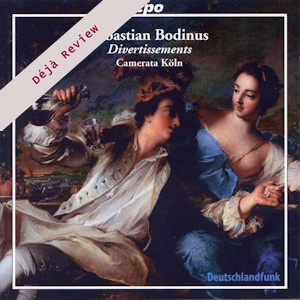
Déjà Review: this review was first published in July 2006 and the recording is still available.
Sebastian Bodinus (c1700-c1760)
Divertissements
Camerata Köln
rec. 2003, Studio of Deutschlandfunk, Cologne, Germany
cpo 999 945-2 [59]
This disc is remarkable in more than one way. First of all, Sebastian Bodinus is anything but a household name. Nevertheless this ‘minor master’ appears to have written first-rate music, as this recording proves. Secondly, the ‘divertissements’ presented here have nothing to do with the ‘divertimenti’ of the classical period. They are quartets: pieces consisting of three equal upper parts and basso continuo, and combining elements of the sonata da chiese, the concerto and the suite. The quartet was very rare in the time Bodinus composed his: the 1720s and 1730s. According to Johann Joachim Quantz “the use of it never became very common; as a consequence, it also cannot have been so familiar to everybody”. The best-known composer of quartets was Georg Philipp Telemann, whose ‘Quadri’, published in 1730, were perhaps models for the quartets of Bodinus, which belong to a six-part collection of trios and quartets, which he started to write in 1726.
Very little is known about Bodinus. He was born in 1700 in Saxe-Gotha; the exact place and date of his birth are unknown. He was educated as violinist, and in 1718 he entered the service of Margrave Carl III Wilhelm of Baden-Durlach. At his court in Karlsruhe the margrave also engaged Johann Melchior Molter, who became music director in 1722. At several stages of his life Bodinus worked elsewhere, but he always returned to Karlsruhe, where he was appointed concertmaster in 1728. In 1759 he died in a madhouse in Pforzheim.
It is not surprising that Bodinus, being a violinist, composed and published several collections of solo sonatas for his instrument. In the booklet Quantz is quoted as writing: “Nowadays composing a solo is no longer regarded as involving any special skill. Almost everyone occupies himself with it.” Bodinus may have been aware of this, and set out to compose trios and quartets. The fifth and sixth parts of his collection of ‘Divertissements’ consist of three quartets each, with three different scorings. Not only is the writing of three upper parts uncommon, but also the choice of instruments. In particular the horn was seldom used in chamber music, and the viola mostly appeared in pieces for strings alone. Although the instruments are treated equally, the violin often plays a concertizing role, reflecting the profession of the composer.
There is much variety in the way Bodinus has composed these six quartets. The horn part in the Sonata III in D is much more elaborate than in the Sonata I, where it also keeps silent in the slow movement. The two quartets with two flute parts are also very different. In the Sonata II in A the violin has a virtuosic solo part, whereas the two transverse flutes, mostly playing parallel to each other, act like the tutti in a solo concerto. In the Sonata I in D, on the other hand, the two flutes are treated independently. This is underlined here by playing one of the flute parts on the recorder – a questionable decision. The two quartets with viola are reminiscent of the quartets by Telemann, in particular the Sonata III in e minor. The slow movements of both quartets are very expressive: in the e minor quartet the flute and violin are involved in a dialogue, whereas the viola is acting like a basso continuo. In the slow movement of the Sonata II in G the flute takes the lead, supported by violin and viola. The booklet says that both slow movements are ‘senza basso’ (without a basso continuo part), but then why do I hear a guitar in the adagio of the Sonata III? All three quartets are in three movements, but the two Sonatas with horn open with a binary movement, consisting of a slow and a fast section.
I have enjoyed this disc immensely. This is simply excellent music, and it is a complete mystery to me why these pieces have never been recorded before. I strongly recommend this recording, not only because of the music, but also because of the playing of the Camerata Köln. The ensemble delivers very lively and sensitive interpretations, which show a deep understanding of the character of German instrumental music of the 18th century. From a technical point of view all instruments are well recorded. It is only in the first movement of Sonata II that the viola is not clearly audible.
Johan van Veen
Help us financially by purchasing from

Contents
[Musicalische Divertissements, Part V]
Sonata I for violin, transverse flute, horn and bc in D
Sonata II for violin, 2 transverse flutes and bc in A
Sonata III for violin, transverse flute, viola and bc in e minor
[Musicalische Divertissements, Part VI]
Sonata I for violin, 2 transverse flutes [recorder, transverse flute] and bc in D
Sonata II for violin, transverse flute, viola and bc in G
Sonata III for violin, transverse flute, horn and bc in D


















